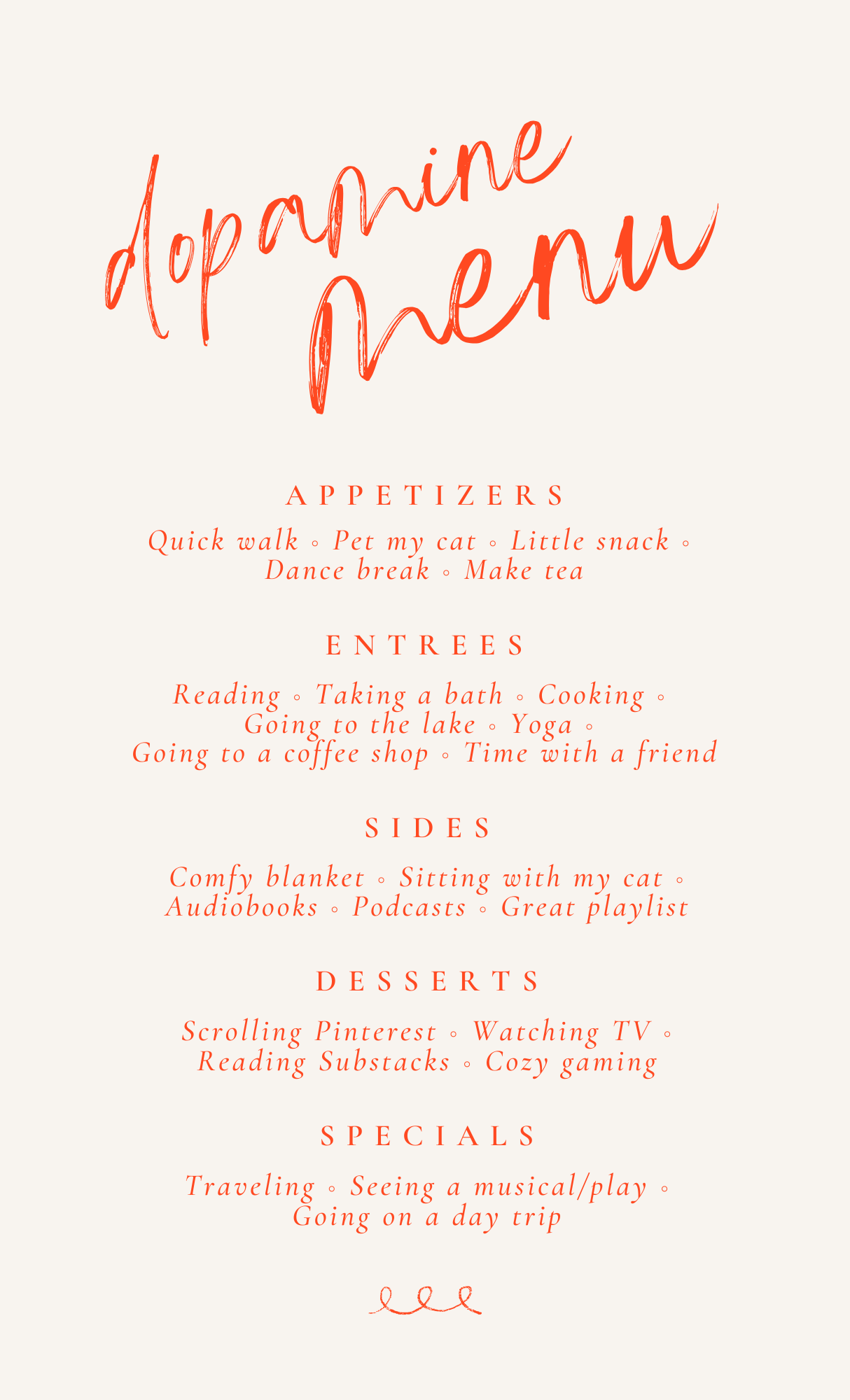I love winter, but it can be a particularly heavy time of year. There’s a lot going on in the world, compounded by shrinking daylight, and here in Wisconsin, it gets unbelievably cold. While I try to combat the darkness and subzero temperatures by embracing hygge and slowing down, I find that in the winter season, it’s harder for me to summon motivation and resilience. So when I heard of a dopamine menu, I was intrigued.
I was first introduced to the idea on TikTok. The hashtag has over 17 thousand posts associated with it. You’ll find videos of people creating adorable menus filled with simple mood-boosting activities. While this may be a fun internet trend, it’s also a tried-and-true mental health tool that we can use to feel more motivated and regulated as we move about our life during a particularly difficult season.
A dopamine menu is a list of healthy activities that can provide you with a burst of dopamine. Dopamine is a neurotransmitter commonly known as the “feel-good hormone.” It’s released when you do something enjoyable or good for yourself, like checking something off your to-do list or exercising.
“A dopamine menu is a list of healthy activities that can provide you with a burst of dopamine.”
“Dopamine is really the [neurotransmitter] that we praise on this golden pedestal as being the feel-good chemical,” says Elise Robinson, LCSW, a New Jersey and Massachusetts-based psychotherapist and founder of Mindful Care Therapy. “It’s the one that we can have a release of very quickly, but it can be very short-lasting. We feel good at that moment.”
Dopamine menus originated as a tool for folks with ADHD — who some believe have lower levels of dopamine — to have an accessible list of activities that can increase dopamine. “When we talk about dopamine menus in the neurodivergent space, we are talking about regulation,” Robinson says. But dopamine menus can be helpful for anyone. “We all move through different states of regulation all day long,” she says. “Are you hungry? Are you tired? Did your boss just email you and you’re freaking out? You got this text from your partner saying, ‘Hey, I want to talk to you.’ All of these things change how regulated we are.”
The reason why it’s called a dopamine menu is because it’s organized into different categories based on the amount of time, energy, and resources that each activity takes. “We’re streamlining how much energy it takes,” Robinson says. “We call it activation energy, getting something started. We’re removing an obstacle by having this done already [when we create a dopamine menu].”
You’ll recognize the components of a dopamine menu from your experience at most restaurants. Here’s how to think about each category:
APPETIZERS
These are the small things you can do for a quick boost of dopamine, usually taking 5–15 minutes. Some examples are having a dance break, petting your cat, eating a little snack, and making a cup of tea. “We’re all struggling to have more time, so I really like to encourage appetizers, those quick activities that also aren’t going to suck you in,” Robinson says.
ENTRÉES
Entrée activities take a bit longer and are good for when you need a true break. Some examples are reading, taking a bath, cooking your favorite meal, doing a yoga flow, or going to a coffee shop.
SIDES
Imagine sides as things that you can do simultaneously with another activity. Maybe it’s listening to a playlist while you work, putting on comfortable clothes, wearing a weighted blanket, or listening to an audiobook while you fold laundry. “I love to encourage people that I work with to look at sides as something to bring some niceness to our have-to’s of life,” Robinson says.
DESSERTS
This is the part of your menu for the things that you can do for a quick boost, but only in moderation. These are things like scrolling social media, marathon-watching a TV show, or online shopping. “You’re putting something on there that you know is just a feel-good, self-soothing thing,” says Robinson. “That’s okay, that’s the point of this. But also keep an eye on: ‘Am I always leaning toward this one? Maybe I could put a timer on, set a limit for this.’”
SPECIALS
Specials are just what they sound like, activities that you save for special occasions. For example, taking a vacation or going to a concert.
Find a time when you’re feeling good to make your dopamine menu. “The best time to make these types of lists is when you don’t feel like you need it consistently,” Robinson says. “You’re going to be creative. You’re going to have the energy to do it, the interest in doing it.”
“Find a time when you’re feeling good to make your dopamine menu.”
Make an activity out of creating it — maybe get some friends together and make an evening of it or carve out some alone time to sit and do it. List out activities that make you feel good and separate them into the different categories based on the amount of time and energy they take to do. And be specific! You want to make this as easy as possible for your future self to choose from.

Robinson recommends coming up with a bunch of items per category, then selecting items from that master list that feel exciting and good to you at a given time. “We get to change it through the seasons and our interests,” says Robinson. “As soon as you notice that you continue to just not lean towards one or avoid one, throw it away, put something new on there.”
I created my dopamine menu and then designed it in Canva. Making it look like a cute little restaurant menu made me feel more excited about using it. Plus, it was fun to take time to design it, the process of making it dopamine-inducing itself. I’ve also seen people create them in their bullet journals or just simply in a Google Doc. You get to make it your own, so do what works best for you.
“You get to customize and list only pleasure-filled, healthy activities for yourself, depending on what season you’re in,” says Robinson. “If we can make [a dopamine menu] now before the blues and the sadness come in, we’re taking a barrier away from ourselves in terms of having to think about something to help us when we already are a bit down.”
One way to use a dopamine menu is to help us get through the winter months, which can impact our dopamine levels. “When light is darker, when weather is colder, we tend to be indoors more, and we have less of the natural dopamine happening,” Robinson says. And this can lead to seasonal affective disorder, whether that’s anxiety, depression, or just cyclical patterns of needing more dopamine. Winter is also correlated with a more stressful time of year, with the holidays and times of financial stress, she says. “We really have to get the ball rolling to have motivation maintain itself.”
“Winter is also correlated with a more stressful time of year, with the holidays and times of financial stress.”
Using a dopamine menu in winter months is a great way to help ourselves feel motivated to do things when it’s harder to do them naturally. When you’re feeling unmotivated or need a pick-me-up, you can pick an item off of your dopamine menu, based on how much time you have, and do it to help you feel better — and hopefully, it will help you feel more regulated to get what you need to accomplish done.
“Being able to have those dopamine resets are extremely helpful and important, because we do have tasks and things that we do have to get done,” says MacKenzie Dressing, LMFT, an intake therapist at Lifebulb Counseling Services. “Here are our resets, here’s what we’re going to do to be able to restart and continue to do life.”
“Using a dopamine menu in winter months is a great way to help ourselves feel motivated to do things when it’s harder to do that naturally.”
Robinson recommends utilizing your dopamine menu to try to get ahead of a potentially stressful or busy week. “When you know you have a lot coming, go ahead and take a peek at your list and throw some things into your week or your day to raise your social battery, raise your human battery, and be able to go through those [stressors] before they start using your energy and draining you.” That way, you can use your dopamine menu to build these activities into your schedule based on how much time you have.
“Dopamine menus can also be a great way to help us connect with others during winter, a time where we generally get less social interaction.”
Dopamine menus can also be a great way to help us connect with others during winter, a time where we generally get less social interaction. Many will also cease social connection when they’re feeling overwhelmed, so a dopamine menu can help with that too.
“When we’re not feeling like we’re getting our dopamine, we can be more irritable. We can feel more angry,” says Dressing. After doing an activity from your dopamine menu, try pairing that dopamine burst with connecting with someone you care about. “Really make it a time for calling a friend, calling somebody, or having a coffee break, or going to get lunch. To be able to have those connections is huge.”
And while this is a tool that can help us with regulation and motivation, it should also be fun. Be creative with it, add items that bring you joy, and use it to feel good. Print it out and put it on your refrigerator or above your desk. Have it accessible on your phone. Use it as a reminder to take care of yourself this season. You deserve it.
Brianna Schubert is a writer and editor living in Milwaukee, Wisconsin. When she’s not writing about books, lifestyle, and culture, you can find her cooking up a new recipe, reading and recommending books, or finding hidden gems at vintage and thrift stores. Say hi on Instagram!


